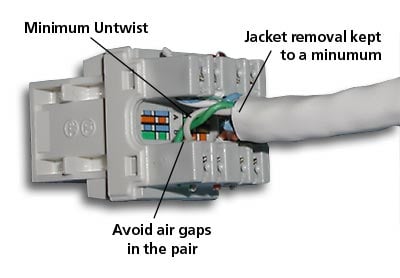カテゴリー 6, 5e および 5 コネクターの終端処理
| ANSI/TIA/ 568-C.0 平衡ツイストペア・ケーブルに成端された接続ハードウェアの設計性能を維持することが重要です。これは、接続ハードウェアのメーカーの指示に従い、平衡ツイストペア・ケーブルを適切な接続ハードウェアで成端することで達成できます。接続ハードウェアの指示が存在しない場合、ケーブルの形状を可能な限り接続ハードウェアに近いものにし、ケーブルの成端部分および平衡ツイストペア・ケーブル終端のねじれのないペアの最大長は表 1 に従うものとします。 To maintain the cable geometry, remove the cable sheath only as much as necessary to terminate the cable pairs on the connecting hardware. The connecting hardware manufacturers instructions for cable sheath strip-back shall be followed. When terminating category 5e and higher cables, the cable pair twists shall be maintained to within 13 mm (0.5 in) from the point of termination. When terminating category 3 cables, the cable pair twists shall be maintained to within 75 mm (3 in) from the point of termination. For best performance, when terminating cable on connecting hardware, the cable pair twists should be maintained as close as possible to the point of termination. In reality, if you allow the installer to have 13 mm (0.5 Inch) untwist, the performance of the cabling system will be reduced. On short links, that could result in a failure. You should aim for no untwist in the pairs for Category 6 as shown below:  Editors comment: Some customers feel that this is unrealistic. We know what it takes to achieve a PASS, and this one critical element to ensure that. Cenelec EN50174 Part 2 The connecting hardware used for copper cabling shall be installed to provide minimal signal impairment by preserving wire pair twists as closely as possible to the point of mechanical termination (by not changing the original twist), see EN 50173. In addition only a minimum of cable jacket shall be removed. Will adding extra twists degrade the performance? No, despite what it says above - by not changing the original twist. You will always find that one of the pairs does not have a tight twist. On occasions its almost impossible to keep the twist to the IDC. Adding an extra twist in that pair will not only improve NEXT, but Return Loss as well. Try it for yourself. Particularly important for block wiring with SYSTIMAXs 110 IDC and TEs Ultimate. Don't overdo it, though. Be careful that you dont cause one wire in the pair to wrap around the other wire while the latter remains relatively straight. You'll introduce NEXT and may cause a failure. |




